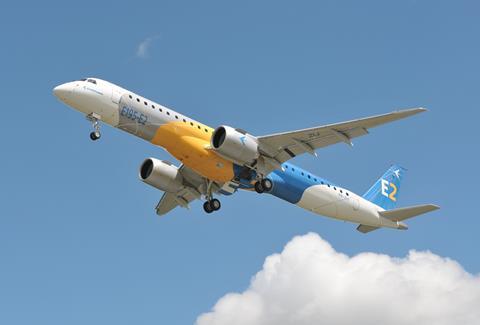Collapse of merger with Boeing leaves the Brazilian airframer needing to detail an alternative.
If Embraer’s senior executives wanted to reassure investors that they were responding swiftly and nimbly to Boeing’s ruthless bulldozing of their entire strategy, they managed only to reinforce the view that the Brazilian manufacturer did not have a Plan B.
Acrimony and a dearth of even basic details – such as the specific fine-print reasons for Boeing’s decision, perhaps not in its gift to provide, or the framework of a fall-back position – were more indicative of a leadership in temporary shell-shock than one coolly steering a confident course through corporate crisis.

Unexpected and involuntary isolation means several of the reasons why the tie-up was beneficial for Embraer have become burdensome considerations.
Its backlog, which might have been stimulated by Boeing’s connections, has yet to reverse a four-year decline, and the older E1 variants are outselling the re-engined E2 which – lessors aside – is still seeking elusive blue-chip customers, with the notable exception of KLM. All while the CSeries-now-A220 is rocking up to fights with heavyweight muscle it could never have summoned under Bombardier.
The C-390 airlifter will have to compete from a standalone position, missing out on sales paths through the US government, while Embraer’s pool of engineering talent will be a more costly and underused resource without a future Boeing project to also work on.
Embraer’s commercial aviation division, its largest revenue contributor, made a R$266 million ($66 million) operating loss last year. Its defence and executive jet segments were also loss-making, with only the services division profitable.
None of which is helped by Brazil’s stuttering economy, the spectre of coronavirus, or the Trump-esque nature of the country’s president, Jair Bolsonaro, against whom the Boeing walk-out might – at the time the Amazon was burning – have been championed as an environmentally-minded sucker punch.
Among the many unanswered questions over Embraer’s future is the likelihood of another international partnership. North America is its largest commercial, and second-largest defence, customer and that makes it unclear whether, say, a Chinese-backed Embraer would sit easily with the USA – or Bolsonaro, for that matter, given recent high-profile political sniping.
Embraer understandably feels aggrieved and, as Congreve wrote, heaven has no rage like love to hatred turned. But the airframer should probably avoid reverting to the cliché of Latin hot-headedness when the tricky task of securing its future in this unforgiving climate demands careful, cool and analytical thinking.





























